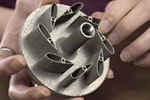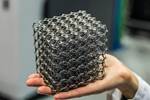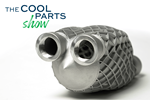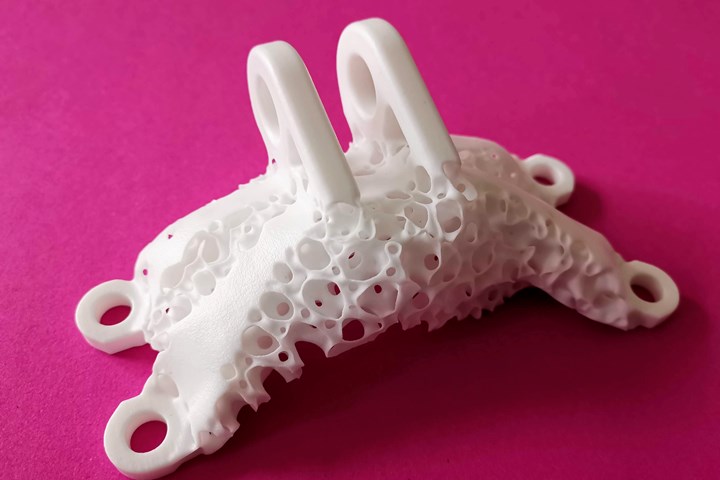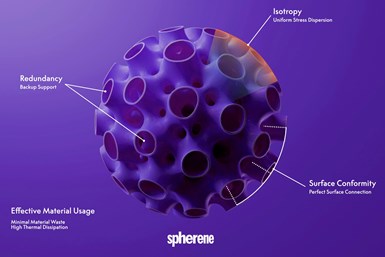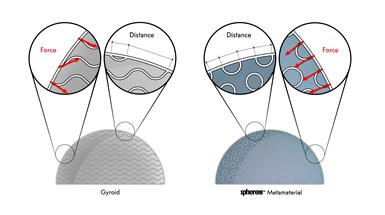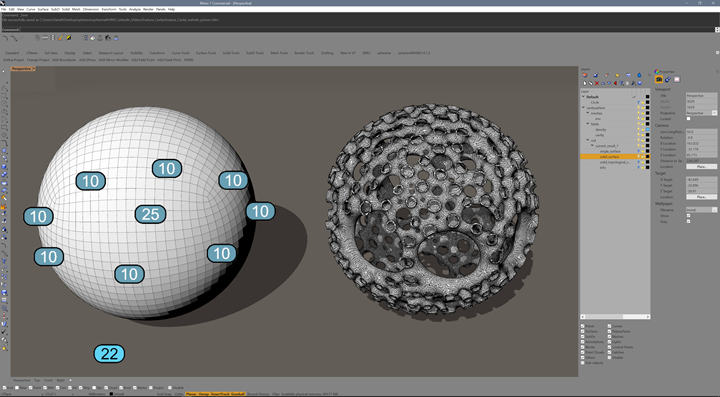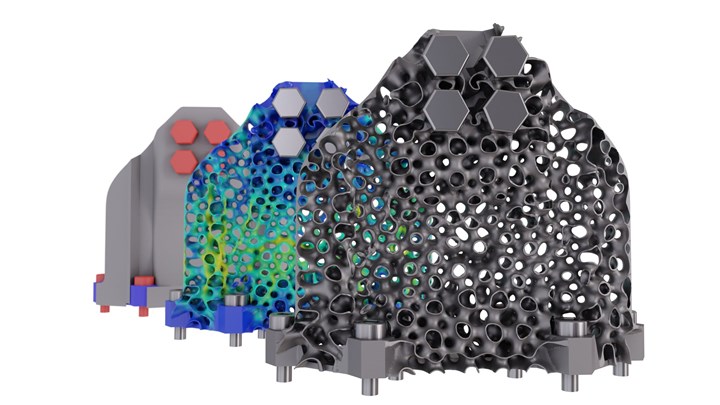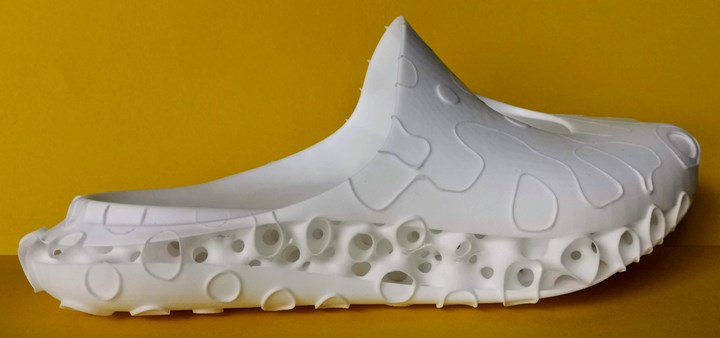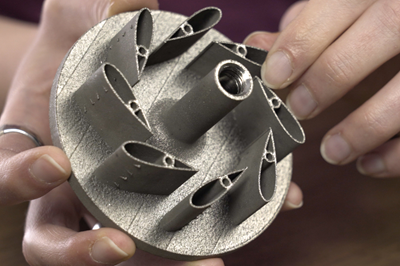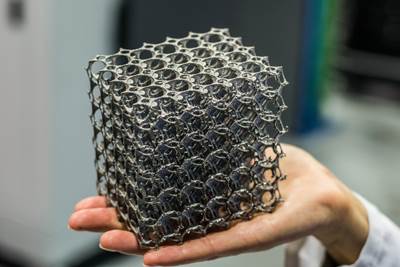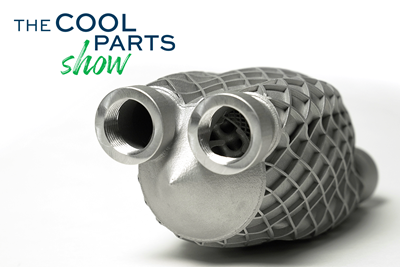Spherene Inc.’s API, currently available through Rhino, offers an infill strategy derived from spheres. The resulting structures are isotropic, provide redundancy in the event of failure, and are efficient in their material use. Source: Spherene Inc.
Triply Periodic Minimal Surfaces (TPMS) such as the gyroid have become common design elements for additively manufactured parts, but Spherene Inc. has developed a novel metamaterial geometry based on a different class of material-minimizing forms: spheres, or more specifically inverse spheres, which the company calls spherenes.
Spherene structures distribute stress evenly while minimizing the amount of material used. Source: Spherene Inc.
The Switzerland-based startup offers an algorithm by way of a cloud-based API that can fill a design volume with an Adaptive Density Minimal Surface (ADMS), essentially geometry that follows inverted spherical surfaces to create a strong yet open framework within the part. Each spherene is just one continuous element, consisting of two labyrinths (one front or anterior, and one back or posterior).
Spherene Inc. says that its metamaterial can better distribute stress compared to gyroid structures. Source: Spherene Inc.
“Spheres are the ideal shape to guide stresses around an empty volume. A spherene does the opposite: it distributes stresses across the interior of a volume in an ideal manner,” says Daniel Bachmann, Spherene Inc.’s Creative Technologist and one of its four current employees. The company’s founder, Christian Waldvogel, is a former architect and artist who came to the realization that minimal surfaces could be seen as inverted, space-filling spheres while experimenting with a paper model of septagons. Spherene Inc. was formed in 2018 to commercialize the opportunity to incorporate such structures into parts made additively.
Rather than a standalone software program, Spherene Inc. has created a cloud-based API that integrates with CAD software Rhino (and could also be applied within other CAD environments). The company also offers services to integrate spherene structures into customer CAD models, and plans to provide commercial licensing of the spherene metamaterial as well.
Spherene Inc. chose to integrate its API with Rhino for a streamlined user experience. Designers can create their CAD model as usual, and then apply the company’s algorithm to incorporate spherene structures as desired. Source: Spherene Inc.
Designing with Spherene Structures
Using the Spherene API requires the user to first define a model in CAD, which then serves as the computation envelope within which the spherene geometries will be generated. Depending on the choices made by the designer, the model might be filled with a consistent density and fixed-thickness spherene, or it might incorporate gradients of density and thickness, cavities, or solid regions. The manner in which the spherene meets the envelope (known as the envelope condition) can also be controlled.
Regardless of the inputs or geometric complexity of the envelope, Spherene Inc.’s algorithm will always generate an isotropic minimal surface consisting of two interwoven spaces. Unless specifically instructed to do so, the algorithm will never generate a fully closed shape, thus enabling 3D printing and postprocessing of the structure.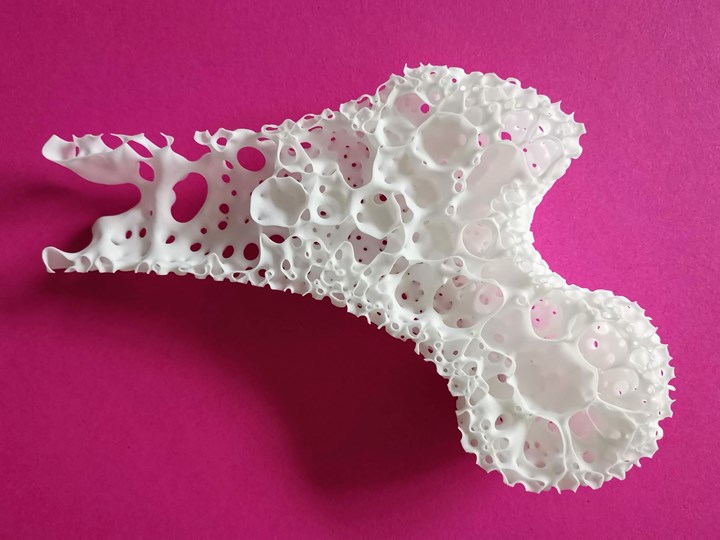
The Spherene API automatically adapts the infill to requirements set by the user, generating structures that resemble coral or bone as seen here. Source: Spherene Inc.
These guide rails mean that users don’t need to deal with specifics of the overall shape or manipulate parameters like pore size or wall thickness to arrive at their desired result; instead, they begin with that desired result expressed in terms of infill density and envelope condition. A higher infill density percentage creates more geometry that might be used to increase stiffness in certain regions for example, while lower densities can be applied to provide flexibility or springiness.
“It alters the entire material,” Bachmann says. “We’re not putting in time for something to fit. Instead, we’re investing that time into what we want to achieve. The spherene metamaterial algorithm does the rest, automatically.”
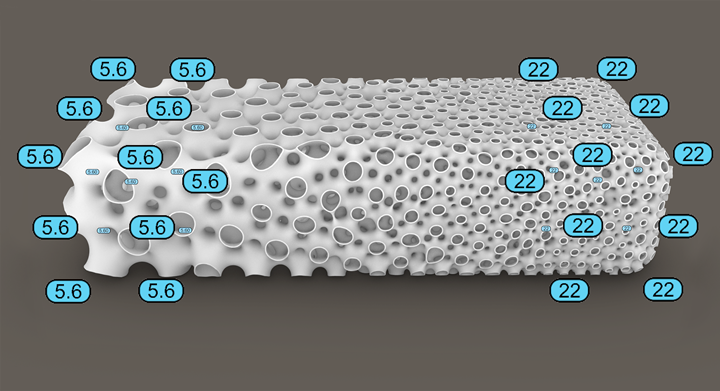
Characteristics such as thickness and density (shown here) can be graded throughout the spherene structure. Source: Spherene Inc.
In many cases, gradients are desirable to create stiffer or more rigid areas of the part, but constant field applications allow for a more precise prediction of how particular 3D printed objects might perform without necessarily relying on simulation and testing.
“You can print a steel part with its density decreased to the point that the steel resembles aluminum — both in terms of weight and strength,” Bachmann says. “Such a metamaterial can be validated just like any other steel. The engineering time and material saved significantly changes the economics of a part.”
The Advantages of Spherene Metamaterial
As an infill strategy, Spherene’s ADMS has some advantages compared to other geometries such as TPMS and beam lattices. Their shape translates to isotropic strength throughout the part volume, and they are self-supporting to manufacture with most 3D printing technologies. According to the company, the surface conformity and controllable envelope condition also enable seamless assembly integration with these structures.
This graphic illustrates the workflow for developing this bracket for the European Space Agency (ESA). The design envelope was first created in CAD before the spherene structures were generated. The final bracket was 3D printed in aluminum. Source: Spherene Inc.
Since its inception Spherene Inc. has collaborated with a number of partners and customers to validate, test and showcase the capabilities of its technology. Successful demonstration parts have included an ESA satellite bracket, a waveguide for a communication satellite, a lightweight component for a wafer inspection machine and a bioceramic implant tested for bone ingrowth.
Spherene Inc.’s design tool is currently in public Beta and available to testers free of charge. The spherene metamaterial will be commercially available in the near future first through the company directly then its reseller network. Spherene Inc. also provides client-specific solutions within verticals such as footwear, aerospace, high-performance technology, tooling and medical.
Related Content
Decentralized Manufacturing Network Aims to Make 3D Printers a Shared Global Resource
The 3DOS additive manufacturing network will let OEMs and creators take advantage of open 3D printer capacity anywhere in the world.
Read MoreCopper, New Metal Printing Processes, Upgrades Based on Software and More from Formnext 2023: AM Radio #46
Formnext 2023 showed that additive manufacturing may be maturing, but it is certainly not stagnant. In this episode, we dive into observations around technology enhancements, new processes and materials, robots, sustainability and more trends from the show.
Read MoreActivArmor Casts and Splints Are Shifting to Point-of-Care 3D Printing
ActivArmor offers individualized, 3D printed casts and splints for various diagnoses. The company is in the process of shifting to point-of-care printing and aims to promote positive healing outcomes and improved hygienics with customized support devices.
Read MoreHybrid Additive Manufacturing Improves Debarking Knife Tip Strength and Production Efficiency
Nicholson Manufacturing chose the Mastercam APlus specialized add-on to unlock hybrid manufacturing for making its debarker knife tips, enabling it to add durable layers to the wear surfaces of the tips to make them more resilient while also making the production process more efficient.
Read MoreRead Next
Gas Turbine Swirlers: Co-Optimizing Despite the Complexity
Power generation and additive manufacturing researchers at Penn State University have joined forces to explore what impact the design of a swirler can have on gas turbine performance.
Read MoreWhat Are the Unexplored Frontiers of AM Lattice Fabrication?
A recent literature review discovered that most research into AM lattices is limited to PBF in metal and extrusion in polymer — and that experiments could be underestimating in-service lattice mechanical behavior.
Read More3D Printed Heat Exchanger Uses Gyroids for Better Cooling | The Cool Parts Show #43
Replacement heat exchanger for a helicopter is half the size and delivers 4× the cooling, thanks to a geometry that could only be made via additive manufacturing.
Read More

.jpg;width=70;height=70;mode=crop)
